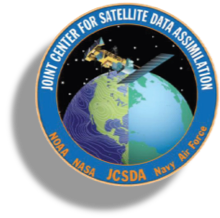Article by Katherine Shanahan (Program Coordinator) and Dr. Wei Han (OBS)
In October 2019, the JCSDA and the University of Wisconsin Space Science and Engineering Center (UW-SSEC) began to collaborate on research involving geostationary hyperspectral IR sounder (GeoHIS) data assimilation in the JEDI framework using GIIRS as a precursor. Dr. Wei Han is currently a UCAR/UCP/JCSDA employee and visiting scientist at the UW-SSEC focusing on GIIRS evaluation and JEDI. He has developed a fast and accurate spectral shift estimation and correction algorithm, allowing him to find the root cause of the GIIRS diurnal and seasonal spectral shift. This information will be beneficial for future GeoHIS sensor development, data monitoring, and assimilation.
Dr. Wei Han, visiting scientist at UW-SSEC and core observations team members at the JCSDA.
Dr. Han recently presented at the Twenty-third International TOVS Study Conference (ITSC-23), hosted by the International TOVS Working Group June 24-30, 2021. According to the UW-SSEC newsletter, over 250 people registered to attend the virtual conference. At the close of the conference, attendees were asked to vote for best oral and poster presentations. Dr. Han won for best oral presentation for his talk Assimilation of Geostationary Hyperspectral InfraRed Sounders (GeoHIS): progresses, challenges and perspectives.
His presentation illustrated the importance of GeoHIS data assimilation for the future of forecasting. High temporal GeoHIS radiance measurements enable continuous sounding of the atmospheric temperature and moisture, and thus capture the temporal and spatial variability for high impact weather or rapid changing weather events. This will benefit the regional and global numerical weather prediction, especially for the improvement on high impact weather forecasts. Such a global GeoHIS (as shown in Figure 1 below) ring will dramatically improve our ability to monitor storms and hurricanes through their complete life cycles, and could provide high spatial and temporal information of atmospheric temperature and moisture structures.
Figure 1. Global GeoHIS ring anticipated around 2030. Areas within 75 degrees local zenith angle from future global ring of GHS. FY-4A was launched in 2016, each geostationary satellite covers around 60 degrees in both latitude and longitude directions.


